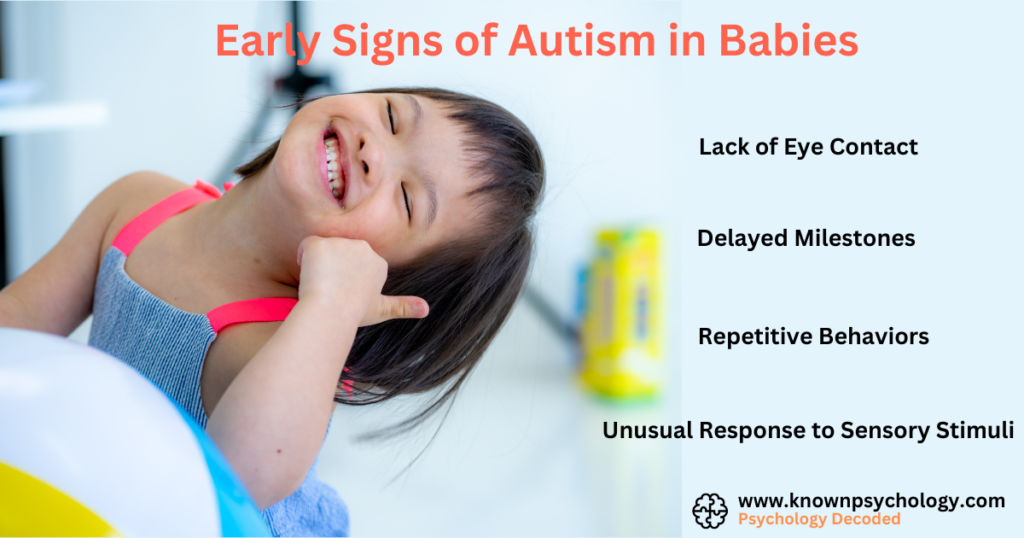
Autism Spectrum Disorder (ASD) is a developmental disorder that can cause significant social, communication, and behavioral challenges. Recognizing the early signs of autism in babies can be crucial for parents and caregivers, as early intervention can make a significant difference in a child’s development. In this blog, we will explore the early signs of autism in babies and provide guidance on how to navigate these early indicators.
What is Autism Spectrum Disorder?
Before diving into the early signs, it’s important to understand what Autism Spectrum Disorder is. Autism is a broad range of conditions characterized by challenges with social skills, repetitive behaviors, speech, and nonverbal communication. The effects of autism and the severity of symptoms vary widely across individuals, which is why it is referred to as a “spectrum.”
Early Signs of Autism in Babies
Identifying autism early in life can be challenging, as symptoms can vary widely and may overlap with other developmental delays. However, there are several early indicators that can suggest the presence of ASD:
Lack of Eye Contact
One of the earliest signs of autism in babies is a lack of eye contact. Babies typically begin to make eye contact from an early age. If you notice that your baby rarely looks at you or other caregivers, it might be a sign to consult a professional.
Delayed Milestones
While every child grows at their own pace, certain delayed milestones can be indicative of autism. These can include delays in babbling, pointing, and other forms of nonverbal communication, as well as challenges with social interactions such as smiling.
Repetitive Behaviors
Babies with autism might display repetitive behaviors such as rocking, spinning, or hand-flapping. While some repetitive motions are normal for babies, those with autism may perform these actions more frequently or intensely.
Unusual Response to Sensory Stimuli
Babies with autism may react unusually to sensory stimuli. This can include either over-sensitivity or under-sensitivity to sounds, lights, and textures. They might show little response to pain or an aversion to cuddling.
How to Navigate Early Signs of Autism in Babies
Navigating the early signs of autism involves careful observation and professional consultation. Here’s what you can do if you suspect your baby may be showing signs of autism:
Keep Detailed Records
Document your observations about your child’s behavior, including what behaviors you find unusual, their frequency, and the context in which they occur. This information can be very helpful to healthcare providers in making a diagnosis.
Consult with Professionals
If you notice any signs that concern you, consult with your pediatrician. They may refer you to a specialist in child development who can conduct a more detailed evaluation.
Early Intervention Services
Early intervention is crucial in helping children with autism. These services can include therapy to help with speech, physical coordination, and social skills. Engaging with these services early can help improve outcomes for children with autism.
A note from Known_Psychology
Recognizing the early signs of autism in babies is the first step towards getting the necessary support and interventions. While the signs can be subtle, early detection and intervention can significantly impact the quality of life for children with ASD. If you suspect your baby shows signs of autism, consult with healthcare professionals to begin the journey of support and growth.
Mariam holds an MS in Sociology with a specialization in Medical Sociology and Social Psychology. With a strong academic background and extensive research work in both fields, she brings depth and clarity to complex topics. Her writing explores the intersection of society, health, and the human mind, making academic ideas easy to grasp and relevant to everyday life.



Hi, Neat post. There is a problem with your web site in internet explorer, would check this… IE still is the market leader and a big portion of people will miss your excellent writing due to this problem.
Whats up this is kinda of off topic but I was wanting to know if blogs use WYSIWYG editors or if you have to manually code with HTML. I’m starting a blog soon but have no coding experience so I wanted to get advice from someone with experience. Any help would be enormously appreciated!
I¦ve recently started a web site, the information you offer on this site has helped me greatly. Thank you for all of your time & work.
Yay google is my queen aided me to find this outstanding internet site! .
Thank you for the good writeup. It if truth be told was a entertainment account it. Glance complicated to far brought agreeable from you! However, how can we be in contact?
It¦s actually a cool and helpful piece of info. I¦m glad that you shared this helpful information with us. Please keep us up to date like this. Thanks for sharing.
With your post, your readers, particularly those beginners who are trying to explore this field won’t leave your page empty-handed. Here is mine at FQ6 I am sure you’ll gain some useful information about Thai-Massage too.
I would like to thank you for the efforts you have put in writing this site. I’m hoping the same high-grade web site post from you in the upcoming as well. In fact your creative writing abilities has encouraged me to get my own website now. Actually the blogging is spreading its wings quickly. Your write up is a good example of it.
Pingback: What are the early Intervention for Autism?
Pingback: Autism Behavioral Therapy as early Intervention for Autism